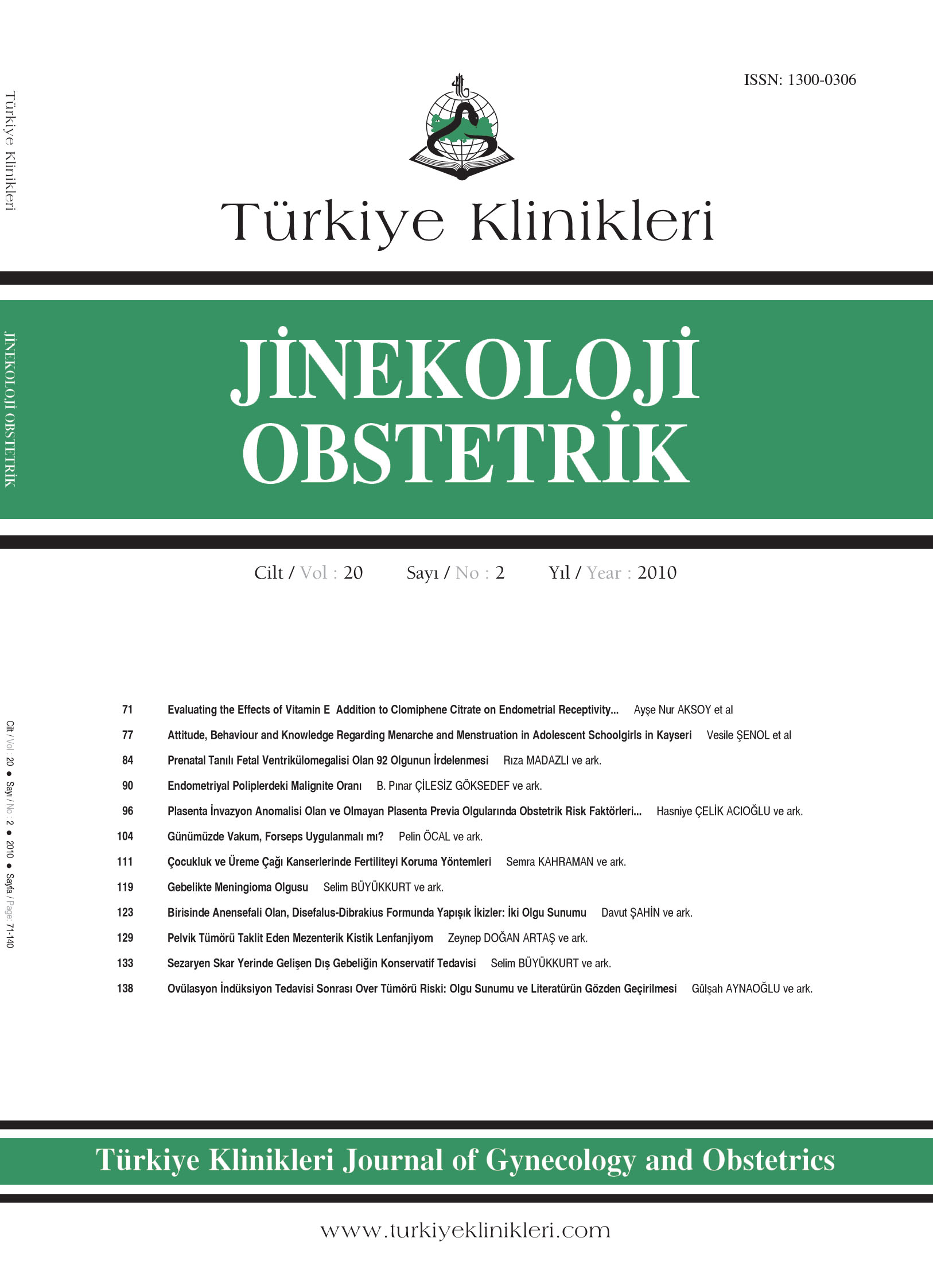Open Access
Peer Reviewed
CASE REPORTS
7667 Viewed1477 Downloaded
Conservative Treatment of the Ectopic Pregnancy in the Cesarean Scar Site: Case Report
Sezaryen Skar Yerinde Gelişen Dış Gebeliğin Konservatif Tedavisi
Turkiye Klinikleri J Gynecol Obst. 2010;20(2):133-7
Article Language: TR
Copyright Ⓒ 2025 by Türkiye Klinikleri. This is an open access article under the CC BY-NC-ND license (http://creativecommons.org/licenses/by-nc-nd/4.0/)
ÖZET
Sezaryen skar gebeliği nadir görülen bir dış gebelik türü olup, ölümcül sonuçlara neden olabilir. Tedavisinde histerektomi ya da koruyucu seçenekler vardır. Uterusu koruyucu seçenekler cerrahi (laparoskopik ya da laparotomik alt segment eksizyonu, histeroskopi, kürtaj), medikal [sistemik ya da lokal metotreksat enjeksiyonu, lokal potasyum klorür (KCl) enjeksiyonu] ve minimal invaziv girişimler (selektif arter embolizasyonu) olarak sıralanabilir. İki kez sezaryen geçirmiş bir hastada gelişen sezaryen skar gebeliği önce düşük doz metotreksat ile iyileştirilmeye çalışılmıştır. Ancak bunda başarısız olununca tedavi, yüksek doz metotreksat tedavisi ve uterus arteri embolizasyonuyla değiştirilmiştir. Gebelik kesesinin bozulması sürecindeki kanama ise kürtaj ve servikse balon tamponadı uygulanarak durdurulmuştur. Sezaryen skar gebeliğinde uterusun ve hastanın yaşamının korunması erken tanı ve tedaviye bağlıdır. Sezaryen skar gebeliğinin tedavisinde birden fazla yolun birlikte kullanılmasına ihtiyaç duyulabilir. Düşük doz metotreksatla tedavi başarısının öngörülmesinde ?-hCG düzeylerinin, progesteron düzeyleri ve fetal kalp atımı varlığıyla birlikte değerlendirilmesi daha yararlı olabilir.
Sezaryen skar gebeliği nadir görülen bir dış gebelik türü olup, ölümcül sonuçlara neden olabilir. Tedavisinde histerektomi ya da koruyucu seçenekler vardır. Uterusu koruyucu seçenekler cerrahi (laparoskopik ya da laparotomik alt segment eksizyonu, histeroskopi, kürtaj), medikal [sistemik ya da lokal metotreksat enjeksiyonu, lokal potasyum klorür (KCl) enjeksiyonu] ve minimal invaziv girişimler (selektif arter embolizasyonu) olarak sıralanabilir. İki kez sezaryen geçirmiş bir hastada gelişen sezaryen skar gebeliği önce düşük doz metotreksat ile iyileştirilmeye çalışılmıştır. Ancak bunda başarısız olununca tedavi, yüksek doz metotreksat tedavisi ve uterus arteri embolizasyonuyla değiştirilmiştir. Gebelik kesesinin bozulması sürecindeki kanama ise kürtaj ve servikse balon tamponadı uygulanarak durdurulmuştur. Sezaryen skar gebeliğinde uterusun ve hastanın yaşamının korunması erken tanı ve tedaviye bağlıdır. Sezaryen skar gebeliğinin tedavisinde birden fazla yolun birlikte kullanılmasına ihtiyaç duyulabilir. Düşük doz metotreksatla tedavi başarısının öngörülmesinde ?-hCG düzeylerinin, progesteron düzeyleri ve fetal kalp atımı varlığıyla birlikte değerlendirilmesi daha yararlı olabilir.
ANAHTAR KELİMELER: Gebelik, ektopik; uterus rüptürü; metotreksat; uterusun arterinin embolizasyonu; kürtaj
ABSTRACT
Cesarean scar pregnancy is a rare form of the ectopic pregnancy and its consequences may be fatal. Its treatment is based on the hysterectomy or conservative choices. Conservative modalities may be listed as surgical (low uterine segment excision with laparotomy or laparoscopy, hysteroscopy, curettage), medical [systemic or local use of methotrexate, local potassium chloride (KCI) injection] and minimally invasive interventions (selective uterine artery embolization). A cesarean scar pregnancy was tried to treat with low dose methotrexate regiment in a woman who had two cesareans previously. While this regiment was unsuccessful it was switched to the high dose methotrexate and uterine artery embolization. The bleeding during the destruction of the gestational sac was controlled with curettage and cervical balloon tamponade. Preservation of the uterus and the life of the woman are related to the early diagnosis and treatment. A combination of the many ways may be necessary in the treatment of the cesarean scar pregnancy. The collaboration of the ?-hCG levels as well as the progesteron levels and the presence of the cardiac activity may be more useful in the prediction of treatment success of the low dose methotrexate regiment.
Cesarean scar pregnancy is a rare form of the ectopic pregnancy and its consequences may be fatal. Its treatment is based on the hysterectomy or conservative choices. Conservative modalities may be listed as surgical (low uterine segment excision with laparotomy or laparoscopy, hysteroscopy, curettage), medical [systemic or local use of methotrexate, local potassium chloride (KCI) injection] and minimally invasive interventions (selective uterine artery embolization). A cesarean scar pregnancy was tried to treat with low dose methotrexate regiment in a woman who had two cesareans previously. While this regiment was unsuccessful it was switched to the high dose methotrexate and uterine artery embolization. The bleeding during the destruction of the gestational sac was controlled with curettage and cervical balloon tamponade. Preservation of the uterus and the life of the woman are related to the early diagnosis and treatment. A combination of the many ways may be necessary in the treatment of the cesarean scar pregnancy. The collaboration of the ?-hCG levels as well as the progesteron levels and the presence of the cardiac activity may be more useful in the prediction of treatment success of the low dose methotrexate regiment.
MENU
POPULAR ARTICLES
MOST DOWNLOADED ARTICLES





This journal is licensed under a Creative Commons Attribution-NonCommercial-NoDerivatives 4.0 International License.










